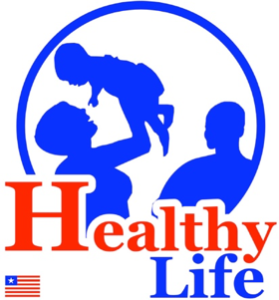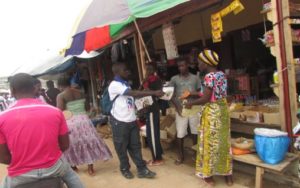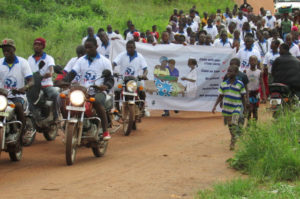Healthy Life – More Than Just a Logo
On a recent trip to Liberia I found myself in a meeting where we were looking at an illustration and discussing the color of a dead rat and also of the plastic bag being used to pick up that rat. A few days later the same people met again and we discussed whether a nurse should be wearing gloves while administering a vaccine and the placement of a hand-washing bucket outside of a toilet.
These may seem like minute details that do not matter much, however ensuring the accuracy of health messages and materials has been a high priority since the start of the Ebola outbreak which was fueled by the spread of rumors and false information taken as the truth. In the early days of the outbreak in particular, people were receiving conflicting information from many sources, including family and friends, health workers, local media, community organizations, pastors, the Ministry of Health and international organizations.
One group within the Liberian Ministry of Health (MOH) stepped in to control the chaotic information environment. The group, known as the Messages and Material Development (MMD) group, had been around before the Ebola crisis began, but took on a larger role in overseeing health communication during the outbreak. Before doing any health communication activities in communities throughout the country, international organizations had to obtain approval from the MMD for any messages and materials, including flyers and posters, billboards, training guides, radio spots, and more. This process of approval ensured that the information being passed on to the Liberian people was accurate, timely, appropriate and consistent with other messaging. In addition, it helped coordinate the myriad communication activities and efforts so that some communities weren’t bombarded by information while others received nothing.
As a result, people in even the most rural communities came to understand how Ebola is spread and as they practiced the recommended preventative behaviors, the outbreak subsided. In the aftermath, communities are still grieving the loss of lives and attempting to recover from the economic toll of the crisis. In addition, they are grappling with questions around who and what to believe after the period of confusion and conflicting messages, coupled with having to abandon deeply rooted social norms and practices as well as the continued fear and distrust of health workers and facilities because of the association with death.
Richard Zeon, chair of the MMD, described the situation as such: “There are a lot of things that Ebola destroyed in this country and that has actually destroyed the conscious of our people… So now that we have interrupted the virus, what remains is to build trust.” This goal of rebuilding trust is the focus of the Healthy Life campaign, recently launched by the National Health Promotion Division (NHPD) of the MOH, with support from HC3.
 At the center of the campaign is the Healthy Life logo, which is being revitalized to serve as a symbol for health in Liberia and also a symbol of the brand. The logo was first introduced many years ago to serve as a stamp of approval, indicating that a health communication material had been reviewed and approved by the NHPD. Over the years, however, the logo was being included on materials that hadn’t been approved, some approved materials didn’t include the logo, and very few people knew what the logo was for. “That is the essence of why we’re having the campaign for the Healthy Life logo,” explained Reverend Sumo, “for people to know about it, to accept it and to use it.”
At the center of the campaign is the Healthy Life logo, which is being revitalized to serve as a symbol for health in Liberia and also a symbol of the brand. The logo was first introduced many years ago to serve as a stamp of approval, indicating that a health communication material had been reviewed and approved by the NHPD. Over the years, however, the logo was being included on materials that hadn’t been approved, some approved materials didn’t include the logo, and very few people knew what the logo was for. “That is the essence of why we’re having the campaign for the Healthy Life logo,” explained Reverend Sumo, “for people to know about it, to accept it and to use it.”
To this end, the Healthy Life campaign will focus on building a brand around the logo, to generate awareness of the logo and what it means. At a most basic level, the image in the logo carries a positive message, as explained by Reverend John Sumo, the Director of the NHPD: “You have the child, the mother and the father – the whole family. When you protect the family you protect the individuals, the community, the society.” However, the brand has a greater purpose than just inspiring good feelings about health.
The brand will also promote confidence and trust in the health system. The MMD approval process ensures the accuracy of Healthy Life branded materials, however most people outside of the inner circle of the MOH do not understand that it signifies that a material has been vetted or approved. To address this, the national launch of the brand was accompanied by county-level launches, to bring the brand to the people. At the county launches, the general public and county-, district- and community-level health workers were introduced to the brand and what it means when they see or hear it. This promotion and awareness raising will continue to be done through future health activities and events, all working toward a vision of “people [seeing] the logo and they know they can trust it because it is from the MOH,” explained Mr. Zeon.
In addition to raising awareness in the general population, another push with the Healthy Life campaign is to encourage wider (but appropriate) use of the branding on health communication materials. At the center of this push is the MMD group that will continue to be the leader of coordinating and validating health promotion messages. This process of approval, explained Reverend Sumo, “helps to control those conflicting messages that we have faced over the years and make sure there is a standard for all of the materials out there.”
So even though the Ebola outbreak is over, the MMD still has an important role to play in preventing future outbreaks, like the current concerns with Lassa Fever and measles, and promoting routine health care, such as vaccination campaigns and ante-natal care visits. Therefore, while it may seem trivial to examine illustrations and debate the color of a rat or whether a nurse is wearing gloves, this level of scrutiny ensures that materials and messages are clear, accurate, high quality and synchronized with other health promotion activities and materials. In the end, giving the Liberian people accurate information that they can trust will not only prevent future outbreaks but also inspire healthier lives every day.










Leave a Reply
Want to join the discussion?Feel free to contribute!